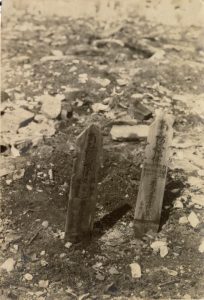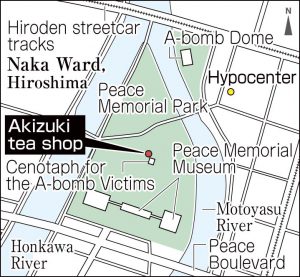Striving to fill voids in Hiroshima, evidence of victims remains—Wooden marker erected on scorched earth year after A-bombing inscribed with names of 9 A-bomb victims of family that ran tea shop
Jun. 20, 2022
Photo taken near present-day Cenotaph for A-bomb Victims
by Kyosuke Mizukawa, Senior Staff Writer
A photograph remains of a wooden grave marker commemorating the first anniversary of the deaths of a family that operated a tea shop near the hypocenter of the Hiroshima atomic bombing by the U.S. military. The photo was believed to have been taken near the site of the shop in an area where the Cenotaph for the A-bomb Victims now stands in Hiroshima Peace Memorial Park, located in the city’s Naka Ward. The wooden marker is inscribed with the names of nine people—a husband and wife, and their children—who died in the atomic bombing. The photo serves as a valuable reminder of the horrific devastation caused by the atomic bombing at a place of mourning that is visited by many members of the public and world leaders.
The photo was found among articles left behind by the late Michio Horibe, who was involved in work, starting in 1946, the year following the atomic bombing, at the Hiroshima Prefectural Hiroshima Reconstruction Office, including the reburial of remains of A-bomb victims. Few photos of memorial services held by members of the public soon after the bombing exist. The photo in question was donated to the Hiroshima Peace Memorial Museum, located in the city’s Naka Ward, by Mr. Horibe’s bereaved family members two years ago. While the wooden marker was clearly inscribed with words relating to the first anniversary of the deaths of the family, no information was available about the people whose names were inscribed on the marker or the location at which the photo had been taken.
For that reason, this reporter began to search for a family with the same name as that inscribed on the wooden marker and set about interviewing bereaved families. As a result of that work, the people whose names were inscribed on the markers were found to be the family of Shuzo Fujimoto, who lived in Nakajima-honmachi, once one of Hiroshima’s busiest downtown areas. Mr. Fujimoto, his pregnant wife, and three children died in the atomic bombing. His mother, as well as an older and a younger sister, also died at that time.
Before the atomic bombing, the family ran the tea shop Akizuki near the present-day Cenotaph for the A-bomb Victims. Mr. Fujimoto’s brother, who was not in Hiroshima Prefecture at the time, collected human remains from the smoldering ruins of the tea shop, but he was unsure of the identity of the remains. The year after the atomic bombing, the bereaved family is believed to have erected the wooden marker near the area where the tea shop was located and held a memorial service, even as none of the family members’ remains could be identified.
After the war, the Hiroshima City government established Peace Memorial Park in an area that included Nakajima-honmachi, a district that was devastated in the atomic bombing. The Cenotaph for the A-bomb Victims, which houses registers of the names of A-bomb victims, was erected in 1952. Hiroshima City has proposed a ceremony involving the dedication of flowers at the Cenotaph for the A-bomb Victims for the leaders of the summit meeting of the G7 (attended by the Group of Seven industrialized nations), scheduled to be held in Hiroshima City next year.
(Originally published on June 20, 2022)









